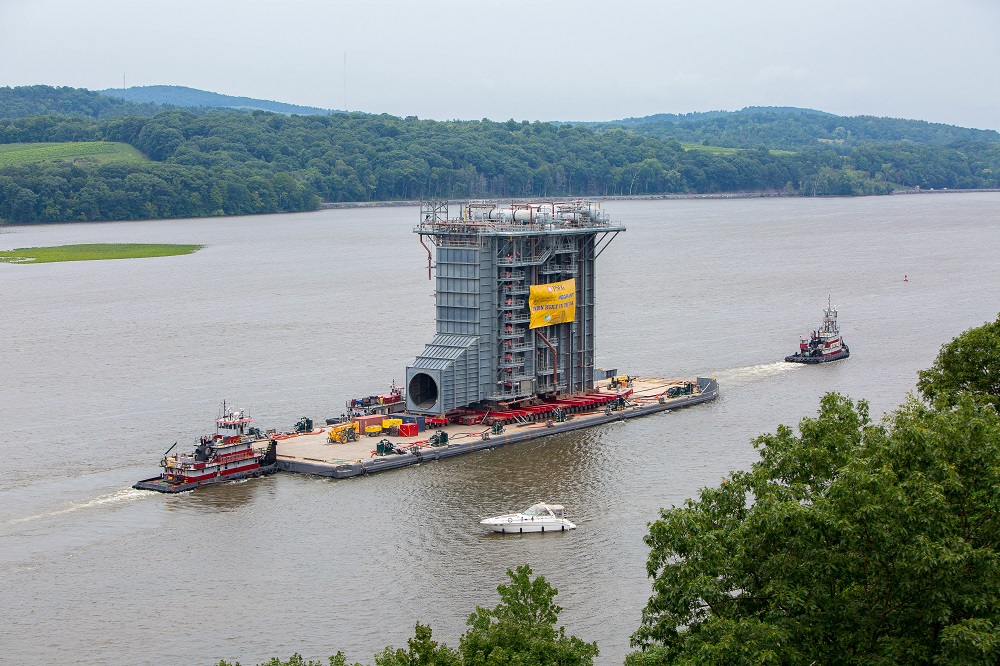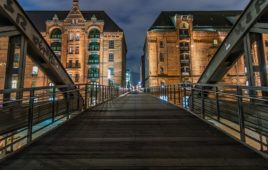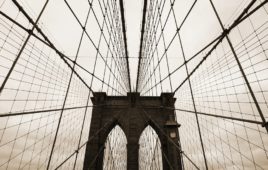
Image credit: GE Power
On a tranquil day in early August last summer, boaters out for a sail on the Hudson River may have noticed something rather strange — an enormous barge carrying what looked like a 12-story structure inching its way beneath the Rip Van Winkle Bridge.
From down below it may have appeared the cargo was close to scraping the underside of the bridge, which spans the river in Catskill, New York. But it was actually 9 feet shy of the clearance, thanks to a team of engineers who had spent over a year consulting with the U.S. Coast Guard to successfully clear that hurdle and the nine others like it along the barge’s route. That odd-looking vessel was actually an 8 million-pound heat-recovery steam generator floating down the Hudson.
The journey — the first of its kind for such a machine — began in 2015, when the New Jersey-based power company PSEG ordered GE’s latest HA-class gas turbine and other equipment for a new combined-cycle power plant in Sewaren, an industrial town tucked away behind New York City’s Staten Island. The machines included a heat-recovery steam generator, or HRSG in power-industry parlance. It recovers waste heat from the gas turbine and turns it into steam that powers a steam turbine to generate more electricity, making the power station more efficient.
GE typically arranges to have all the parts delivered to the power plant for on-site construction. However, as the project began to unfold, it became clear that building the steam generator, which is much larger than the turbines, in New Jersey was going to be a challenge. The site happens to be located in one of the country’s most densely developed areas.
To overcome this challenge, PSEG decided to build the 4,000-ton HRSG in upstate New York and ship it to New Jersey in one piece. GE worked closely with PSEG and construction firm Megrant to crack this logistical riddle.
The team picked the Port of Coeymans marine terminal, just south of Albany and about 100 miles north of New York City, to build the HRSG, which GE supplied as modular pieces. The place had enough space and it was also right next to the river.
It took eight months to assemble the machine. Next, a heavy shipping company helped move the completed HRSG onto a 400-by-100-foot barge, longer than the Statue of Liberty lying on its side, using a fleet of five remote-operated modular transporters. Only three vessels of this kind exist on the Atlantic seaboard.
Fearing heavy winds and waves, the movers lashed the HRSG down tightly enough that it wouldn’t budge, even if the barge tilted by as much as 25 degrees. (Most barges only tip between 2 and 3 degrees during the average trip.) In addition to a tugboat pulling from the front and another pushing from the back, a third, smaller tug ran along the side to add even more stability.
The complications of carrying 4,000 tons of cargo down a busy river came into immediate focus on the very first day, as movers loaded the barge in early-morning light. Positioned horizontally across the Hudson for loading, the barge blocked off almost the entire the river and continued to do so from 6 a.m. until midnight. Two police officers cleared personal watercraft users and sailboats out of the area, while commercial vessels patiently waited for the tugboats to open a wide enough path for them to slip through. Several hours later downstream, the barge found itself in another squeeze at the Tappan Zee Bridge, where major construction allowed the passage of only one vessel at a time.
And because the HRSG stands over 120 feet tall, air traffic control also factored into the trip. At the request of the Federal Aviation Administration, the barge beamed red and white marker lights into the sky to alert small aircraft of its presence.
After 36 hours of traveling at the leisurely speed of 5 knots, the unit finally arrived in Sewaren. There, engineers had installed a temporary steel pier, known as a “spud barge,” as a landing point for the ship. The self-propelled modular transporters that had moved the HRSG onto the barge now moved it onto the foundation. As the unit gently snapped into place, the whole process looked as easy and neat as erecting a Lego set.
Filed Under: Infrastructure




